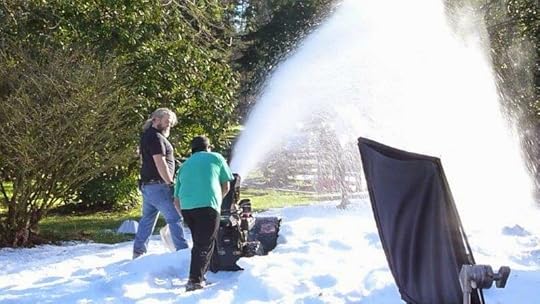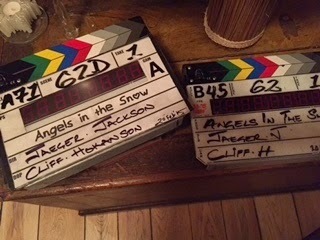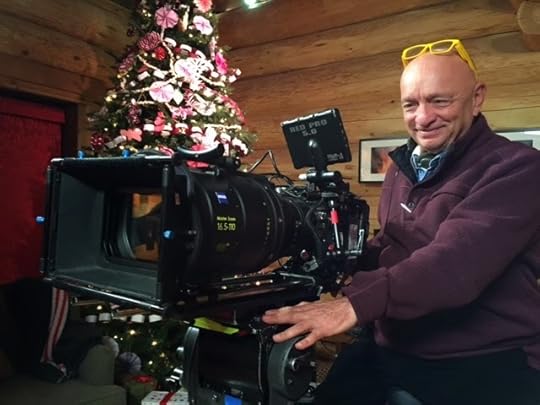Kenneth Atchity's Blog, page 172
March 4, 2015
Guest Post ~ The Last Witness by Jerry Amernic
 Many years ago – just how many it was I have lost count – I got this idea of writing a novel about the last living survivor of the Holocaust. It lingered at the back of my mind for the longest time, and then one day I started putting the story together.
Many years ago – just how many it was I have lost count – I got this idea of writing a novel about the last living survivor of the Holocaust. It lingered at the back of my mind for the longest time, and then one day I started putting the story together.My character was born in 1939 in the Polish city of Lodz. He was Jewish, of course, but was part of the Jewish ghetto which meant that his parents had to hide him from the Nazis. As a little boy of four he would sneak into the Aryan section of the city, going through the sewers, so he could steal food for his family. And so, I learned whatever I could about the Lodz ghetto, the sewers, and the people who tried to avoid being found.
But eventually they were discovered and the family was sent to Auschwitz, the most notorious death camp of the Nazis. My little boy would survive, the only member of his family to do so, and how he made it out of there would be a tale for the ages. And it is.
It’s in my novel The Last Witness.
But fast-forward to his 100th birthday when he’s living in a seniors’ home in New York City. The year is now 2039 and just about everyone he encounters doesn’t know much about the Holocaust. Some people think the whole thing was exaggerated while others don’t believe that it ever happened at all.
To write a novel like this I made a point of meeting real-life, former child survivors, and to say that each of them has a unique story would be an understatement. But I listened to them and took it all in. I also asked these people if any of them thought that my premise about Holocaust ignorance in the near future was far-fetched.
Not one of them did.
However, a publisher who turned down the book had that sentiment, which gave me another idea. I decided to produce a video. A videographer and I spent an afternoon asking university students what they know about the Holocaust and World War II. You can see the video, if you like – http://youtu.be/CRC_T07dwZo – but believe me when I say that the level of knowledge for the next generation of our leaders is pretty damn abysmal.
And for that I blame the schools because they just don’t teach history the way they did when I was young, which only makes my near-future story more relevant. At least, I think so. Hopefully, you will too.
 Publisher: Story Merchant (October 1, 2014) Genre: Historical Thriller ISBN-10: 0990421651 ISBN-13: 978-0990421658
Publisher: Story Merchant (October 1, 2014) Genre: Historical Thriller ISBN-10: 0990421651 ISBN-13: 978-0990421658ASIN: B00P1S0SNK
Buy: Amazon
 , Kindle
, Kindle , IndieBound, The Book Depository
, IndieBound, The Book DepositoryThe year is 2039, and Jack Fisher is the last living survivor of the Holocaust. Set in a world that is abysmally ignorant and complacent about events of the last century, Jack is a 100-year-old man whose worst memories took place before he was 5. His story hearkens back to the Jewish ghetto of his birth and to Auschwitz where, as a little boy, he had to fend for himself to survive after losing all his family. Jack becomes the central figure in a missing-person investigation when his granddaughter suddenly disappears. While assisting police, he finds himself in danger and must reach into the darkest corners of his memory to come out alive.
Reposted from Lori's Reading Corner
Published on March 04, 2015 00:00
March 2, 2015
The Crime Writers Chronicale Interviews Author Dennis Palumbo
Dr. Daniel Rinaldi and the Phantom Limb…
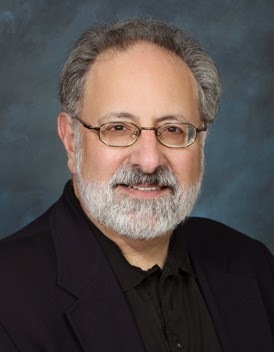 Dennis Palumbo's new smooth-as-silk book with psychologist and Police Department consultant Dr. Daniel Rinaldi—PHANTOM LIMB—will knock your socks off! Page one will hook you… and you won't stop for lunch, dinner or sleep! This new book by Hollywood former screenwriter for bigtime shows grabs you by the throat and does not let you go til the end.
Dennis Palumbo's new smooth-as-silk book with psychologist and Police Department consultant Dr. Daniel Rinaldi—PHANTOM LIMB—will knock your socks off! Page one will hook you… and you won't stop for lunch, dinner or sleep! This new book by Hollywood former screenwriter for bigtime shows grabs you by the throat and does not let you go til the end.
Kirkus Reviews said, "Jack Reacher with a psychology degree." I've read all the Reacher books… and Dan Rinaldi has more heart, soul and compassion!
Dennis is the author of a mystery collection, FROM CRIME TO CRIME, and his short fiction has appeared in Ellery Queen's Mystery Magazine and The Strand.
We are delighted to welcome Dennis Palumbo back to Crime Writer's Chronicle today!
Thelma Straw
Thelma: Is Lisa Campbell based on a real person? Or a composite? You had me by the throat with her first
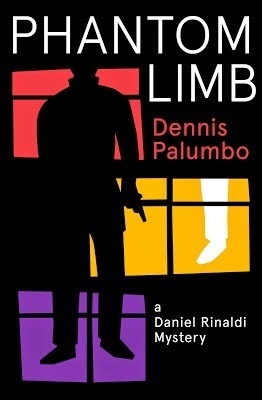 appearance on p. 1.
appearance on p. 1.
Dennis: Prior to becoming a licensed psychotherapist, I was a Hollywood screenwriter for 17 years. During that time I met a number of women like Lisa—women "of a certain age" who were once young, naive actresses exploited for their looks in less-than-meaningful films. In PHANTOM LIMB, the character of Lisa is a composite of such women, for whom I have both sympathy and respect for the fact that they're survivors. Plus, like Lisa, these women tend to have razor-sharp, expletive-laden tongues.
Thelma: You have the cop lingo and mannerisms down pat. Did you train with the police?
Dennis: No, though I've met with a few police detectives over the years. Mostly what little I know comes from research.
Thelma: As a real therapist do you base your characters on real people? Like Noah?
Dennis: Interesting that you should ask that question, since Noah Frye is the only recurring character who is in fact based on a real person. He's loosely based on a patient I met thirty years ago when I was an intern at a psychiatric facility. Like Noah, this person was a paranoid schizophrenic, but as funny, smart and sardonic as a Vegas stand-up comic. Though the details of his life are vastly different than what I created for Noah, he's the source of my character's rueful view of the world and what is commonly thought of as "crazy wisdom."
Thelma: Your dialog and actions move so well - does it come easily or do you re-write a lot?
Dennis: First of all, thanks! I work hard on making the action sequences flow smoothly, which does entail a good bit of re-writing. This is not the case with dialogue. Perhaps because of my former career as a screenwriter, dialogue tends to come easily for me. Plus I love writing it.
Thelma: Daniel Rinaldi is a complex, intriguing man. Where did you find him?
Dennis: Mostly I just looked in the mirror. Like me, he's from a blue collar, Italian-American family, born and raised in Pittsburgh. He's a Pitt grad, a therapist and a bit of a maverick when it comes to some of the more hide-bound beliefs of the mental health profession. We also share the same sense of humor, and a love for the Steelers. Unlike me, he's a former amateur boxer. He's much braver and more resourceful than I am, too. Most of the situations he finds himself in would have me running the other way. Kirkus Reviews calls him "Jack Reacher with a psychology degree." Trust me, that's not a description that would apply to me!
Thelma: You are a superb wordsmith. Your prose is so vivid. I love "Women… defined by their jewelry." Have you always been a writer?
Dennis: Again, thanks for the kind words. Yes, I've been writing since I was in college and worked for the Pitt News. Even after I came to Hollywood to write scripts for TV and film, I was writing prose, mostly mysteries. Fun fact: the same week I was hired to write on staff at the ABC-TV series WELCOME BACK, KOTTER, I sold my first mystery short story to ELLERY QUEEN'S MYSTERY MAGAZINE. I must admit, that was one of the best weeks of my then-young life, for which I was both grateful and astonished!
Thelma: Why do you write mysteries?
Dennis: I guess because I've always loved them. The first time I encountered them was when I was about 10 years old, stuck in bed with the flu, and my Dad got me a hardbound, illustrated ADVENTURES OF SHERLOCK HOLMES. Believe me, it was love at first sight. I haven't stopped reading mysteries since. On a slightly more serious note, I think I enjoy reading—and writing—mysteries because they combine my two favorite aspects of story-telling: a compelling narrative and an exploration of the human condition. Which is probably why I'm so grateful for my dual career as a therapist and a mystery writer: both jobs involve this same exploration.
Thelma: You have worked a lot in other teams. Do you see yourself as a team player rather than as a solo artist?
Dennis: If I understand your question, you're referring to the collaborative nature of film and TV writing. If so, the truth is that this aspect of the creative process in Hollywood was the one I liked the least. One of the joys of novel writing is that it is a solo effort. Other than comments and concerns from my editors (which have always seemed to me to strengthen my books), as a novelist I get to write what I want, how I want. So, if I'm being honest, I guess I'm not much of a team player: as both a therapist in private practice and a novelist, I like working solo!
Thelma: Why did you choose the term "phantom limb" as a title?
Dennis: Actually, it more or less chose me. As you know, one of the main characters in the novel is an Afghan vet who lost a leg in combat and suffers from the condition known as "phantom limb." Though his leg is gone, he still experiences it as attached to his body. It itches; it feels cold. In my novel, I use the phrase "phantom limb" both in its literal sense as a medical condition, but also as a metaphor for that felt sense of loss we all experience when faced with a trauma like a divorce or the death of a loved one. That sense that the missing person is still "here," still in our lives. When we find we have to remind ourselves that the person is in fact gone.
Thelma: In your opinion, why do many crime writers , often mild people, choose such strong themes?
Dennis: Because we all have operatic inner lives! No matter how calm and appropriate our outer persona, the face we show the world, we have within us deep feelings of grief, rage, and passion. I know, because I've seen it for almost 30 years in my therapy practice. I also feel it within myself. That's why perfectly nice people can write about psychopathology, sexual crimes, and violence. I believe, as writers, we all have the whole range of the human condition within us: in other words, we can envisage everything from a nun to a serial killer. Most good writers let this rich, dark, troubling inner world run free on the page… which, by the way, is where it belongs!
Thelma: Harper Lee once said that writers have to have thick skins. What is your comment on that?
Dennis: The thicker the better! And I say this as someone who survived the slings and arrows of a Hollywood writing career. The hard part is having enough sensitivity to create living, breathing characters that reflect real life… and yet a thick enough skin to tolerate rejection, criticism, and failure. If you're like me, sometimes I walk that fine line pretty well, and sometimes I don't. I recall once, when I was grieving a rejection of something I'd written, a friend said to me, "Look, don't take it personally." To which I wanted to respond, "How should I take it? Impersonally?" I think the best way to handle the ups and downs of a writing career is to just keep giving them you, until you is what they want.
Thanks, Thelma, for asking me to participate in this interview. I hope your readers enjoyed it. For those interested in learning more about my Daniel Rinaldi series, please go to www.dennispalumbo.com
Reposted from The Crime Writers Chronicle

 Dennis Palumbo's new smooth-as-silk book with psychologist and Police Department consultant Dr. Daniel Rinaldi—PHANTOM LIMB—will knock your socks off! Page one will hook you… and you won't stop for lunch, dinner or sleep! This new book by Hollywood former screenwriter for bigtime shows grabs you by the throat and does not let you go til the end.
Dennis Palumbo's new smooth-as-silk book with psychologist and Police Department consultant Dr. Daniel Rinaldi—PHANTOM LIMB—will knock your socks off! Page one will hook you… and you won't stop for lunch, dinner or sleep! This new book by Hollywood former screenwriter for bigtime shows grabs you by the throat and does not let you go til the end.Kirkus Reviews said, "Jack Reacher with a psychology degree." I've read all the Reacher books… and Dan Rinaldi has more heart, soul and compassion!
Dennis is the author of a mystery collection, FROM CRIME TO CRIME, and his short fiction has appeared in Ellery Queen's Mystery Magazine and The Strand.
We are delighted to welcome Dennis Palumbo back to Crime Writer's Chronicle today!
Thelma Straw
Thelma: Is Lisa Campbell based on a real person? Or a composite? You had me by the throat with her first
 appearance on p. 1.
appearance on p. 1.Dennis: Prior to becoming a licensed psychotherapist, I was a Hollywood screenwriter for 17 years. During that time I met a number of women like Lisa—women "of a certain age" who were once young, naive actresses exploited for their looks in less-than-meaningful films. In PHANTOM LIMB, the character of Lisa is a composite of such women, for whom I have both sympathy and respect for the fact that they're survivors. Plus, like Lisa, these women tend to have razor-sharp, expletive-laden tongues.
Thelma: You have the cop lingo and mannerisms down pat. Did you train with the police?
Dennis: No, though I've met with a few police detectives over the years. Mostly what little I know comes from research.
Thelma: As a real therapist do you base your characters on real people? Like Noah?
Dennis: Interesting that you should ask that question, since Noah Frye is the only recurring character who is in fact based on a real person. He's loosely based on a patient I met thirty years ago when I was an intern at a psychiatric facility. Like Noah, this person was a paranoid schizophrenic, but as funny, smart and sardonic as a Vegas stand-up comic. Though the details of his life are vastly different than what I created for Noah, he's the source of my character's rueful view of the world and what is commonly thought of as "crazy wisdom."
Thelma: Your dialog and actions move so well - does it come easily or do you re-write a lot?
Dennis: First of all, thanks! I work hard on making the action sequences flow smoothly, which does entail a good bit of re-writing. This is not the case with dialogue. Perhaps because of my former career as a screenwriter, dialogue tends to come easily for me. Plus I love writing it.
Thelma: Daniel Rinaldi is a complex, intriguing man. Where did you find him?
Dennis: Mostly I just looked in the mirror. Like me, he's from a blue collar, Italian-American family, born and raised in Pittsburgh. He's a Pitt grad, a therapist and a bit of a maverick when it comes to some of the more hide-bound beliefs of the mental health profession. We also share the same sense of humor, and a love for the Steelers. Unlike me, he's a former amateur boxer. He's much braver and more resourceful than I am, too. Most of the situations he finds himself in would have me running the other way. Kirkus Reviews calls him "Jack Reacher with a psychology degree." Trust me, that's not a description that would apply to me!
Thelma: You are a superb wordsmith. Your prose is so vivid. I love "Women… defined by their jewelry." Have you always been a writer?
Dennis: Again, thanks for the kind words. Yes, I've been writing since I was in college and worked for the Pitt News. Even after I came to Hollywood to write scripts for TV and film, I was writing prose, mostly mysteries. Fun fact: the same week I was hired to write on staff at the ABC-TV series WELCOME BACK, KOTTER, I sold my first mystery short story to ELLERY QUEEN'S MYSTERY MAGAZINE. I must admit, that was one of the best weeks of my then-young life, for which I was both grateful and astonished!
Thelma: Why do you write mysteries?
Dennis: I guess because I've always loved them. The first time I encountered them was when I was about 10 years old, stuck in bed with the flu, and my Dad got me a hardbound, illustrated ADVENTURES OF SHERLOCK HOLMES. Believe me, it was love at first sight. I haven't stopped reading mysteries since. On a slightly more serious note, I think I enjoy reading—and writing—mysteries because they combine my two favorite aspects of story-telling: a compelling narrative and an exploration of the human condition. Which is probably why I'm so grateful for my dual career as a therapist and a mystery writer: both jobs involve this same exploration.
Thelma: You have worked a lot in other teams. Do you see yourself as a team player rather than as a solo artist?
Dennis: If I understand your question, you're referring to the collaborative nature of film and TV writing. If so, the truth is that this aspect of the creative process in Hollywood was the one I liked the least. One of the joys of novel writing is that it is a solo effort. Other than comments and concerns from my editors (which have always seemed to me to strengthen my books), as a novelist I get to write what I want, how I want. So, if I'm being honest, I guess I'm not much of a team player: as both a therapist in private practice and a novelist, I like working solo!
Thelma: Why did you choose the term "phantom limb" as a title?
Dennis: Actually, it more or less chose me. As you know, one of the main characters in the novel is an Afghan vet who lost a leg in combat and suffers from the condition known as "phantom limb." Though his leg is gone, he still experiences it as attached to his body. It itches; it feels cold. In my novel, I use the phrase "phantom limb" both in its literal sense as a medical condition, but also as a metaphor for that felt sense of loss we all experience when faced with a trauma like a divorce or the death of a loved one. That sense that the missing person is still "here," still in our lives. When we find we have to remind ourselves that the person is in fact gone.
Thelma: In your opinion, why do many crime writers , often mild people, choose such strong themes?
Dennis: Because we all have operatic inner lives! No matter how calm and appropriate our outer persona, the face we show the world, we have within us deep feelings of grief, rage, and passion. I know, because I've seen it for almost 30 years in my therapy practice. I also feel it within myself. That's why perfectly nice people can write about psychopathology, sexual crimes, and violence. I believe, as writers, we all have the whole range of the human condition within us: in other words, we can envisage everything from a nun to a serial killer. Most good writers let this rich, dark, troubling inner world run free on the page… which, by the way, is where it belongs!
Thelma: Harper Lee once said that writers have to have thick skins. What is your comment on that?
Dennis: The thicker the better! And I say this as someone who survived the slings and arrows of a Hollywood writing career. The hard part is having enough sensitivity to create living, breathing characters that reflect real life… and yet a thick enough skin to tolerate rejection, criticism, and failure. If you're like me, sometimes I walk that fine line pretty well, and sometimes I don't. I recall once, when I was grieving a rejection of something I'd written, a friend said to me, "Look, don't take it personally." To which I wanted to respond, "How should I take it? Impersonally?" I think the best way to handle the ups and downs of a writing career is to just keep giving them you, until you is what they want.
Thanks, Thelma, for asking me to participate in this interview. I hope your readers enjoyed it. For those interested in learning more about my Daniel Rinaldi series, please go to www.dennispalumbo.com
Reposted from The Crime Writers Chronicle
Published on March 02, 2015 10:32
February 25, 2015
‘Buffy’ Movie Star Kristy Swanson Joins UP TV’s ‘Angels in the Snow’

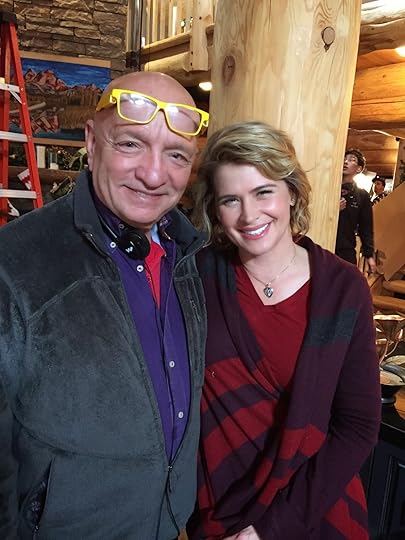 Ken Atchity with Kristy Swanson on the set of Angels in the Snow
Ken Atchity with Kristy Swanson on the set of Angels in the SnowChristmas offering will revolve around two families trapped in a cabin by a blizzard
Kristy Swanson is moving on from vampires to angels.
Swanson, star of the film “Buffy the Vampire Slayer,” has signed on for the UP TV Christmas movie “Angels in the Snow,” which began production last week in Vancouver, Canada.
Based on the Rexanne Becnel novel “Christmas Journey,” the domestic drama revolves around two very different families who find themselves snowbound together in a luxurious cabin during a Christmas blizzard. The affluent yet troubled Montgomery family is headed by workaholic real estate developer Charles (played by Chris Potter of UP’s “Heartland”) and his wife Judith (Swanson) a former New York fashion editor who he’s trying to mend fences with.
The couple bring their three cell phone-dependent, squabbling kids — Alexandra, Jennifer and Emily — on a getaway to the cabin that Charles has built. However, when a snowstorm makes them a prisoner of their “dream home,” the parents start fighting, and Emily makes a wish to keep her parents together.
Meanwhile,the Tucker family show up on the doorstep of the cabin, exhausted and in need of shelter after their van slides off the snow-covered road.
As the families wait out the storm, it soon becomes evident that the Tuckers offer an example of love, togetherness and caring that is seemingly gone from the Montgomerys’ lives. But perhaps the Tuckers’ example — and friendship — can reignite the Montgomery family’s spirit this season.
“The UP premiere movie ‘Angels in the Snow’ is a captivating family drama with heart; strong, diverse characters; and more than a couple of surprises,” UP’s senior vice president, original programming Barbara Fisher said. “Starring fan-favorite Kristy Swanson and popular ‘Heartland’ star Chris Potter as the struggling Montgomerys, the drama is our first Christmas film to go into production this year, and will be a key component of our popular, annual Christmas programming slate in 2015.”
The cast also includes Colin Lawrence (“The 100″), Catherine Lough Haggquist (“Continuum”) and Nick Purcha (“iZombie”), among others.
MarVista Entertainment and Odyssey Media are producing “Angels in the Snow,” with Norman Stephens, Ken Atchity, Kirk Shaw, Keith Shaw executive producing, Chi-Li Wong co- executive producing. Ken Atchity, Chi-Li Wong and Julie Brazier wrote the treatment of Becnel’s novel, with Brazier (UP’s “My Mother’s Future Husband”) responsible for the adapted script.
George Erschbamer (“My Mother’s Future Husband,” “My Name Is Sarah”) is directing.
Reposted from The Wrap
Published on February 25, 2015 11:04
Guest Post: How I got to be a history junkie by Jerry Amernic
Some people get high on alcohol and drugs, but I prefer history. That’s right. I get high on history. My son once said that whenever something was on TV about the Romans, I got excited, and it’s true. The Romans always fascinate me because of how advanced they were on so many fronts. On the other hand, in some areas they weren’t advanced at all. Sounds like today, doesn’t it?
The thing about history is that it’s really about people, and if you don’t find people intriguing then reading books, never mind writing them, isn’t for you.
My first novel Gift of the Bambino was about baseball in the days of Babe Ruth. It was the New York Yankees and the Roaring Twenties. Sure, the story involved a little boy and his grandfather, but the book was full of history. My new novel, complete with flashbacks, is The Last Witness which is about the last living survivor of the Holocaust in the year 2039. The next one, called QUMRAN, soon to be released, is well wouldn’t you know it about an archaeologist who just happens to be an expert on the Romans.
When I was in school, history was my favorite subject and I naturally gravitated to books about a certain people in a certain place and time. In another life I would choose to be an archaeologist or paleontologist or something of that ilk. It’s in my blood, which explains why I’m a member of the local museum and watch the History Channel. Indeed, the idea of holding a fossil that’s 100 million years old, or walking around a site where a community thrived thousands of years ago always gets my juices flowing.
I felt like that exploring the old Viking settlement in Bergen, Norway. I felt like that at the Western Wall in Jerusalem. I felt like that standing in the middle of the Colosseum in Rome.
Who’s to blame? We can probably start with legendary author James A. Michener. Patron saint of the epic historical novel that runs 500, 600 or even 1,000 pages, Michener was a master at taking a place and time, then creating people and putting them in situations that keep you glued to the page, even for many hundreds of pages, and that’s no mean trick.
He penned historical novels like The Source, Centennial, Chesapeake, Mexico, Texas, Poland, and many more. I’ve read just about all of them, and some more than once. Now no one would call Michener a writer of thrillers, and he wasn’t, but if you take history and add spice in the way of suspense – think Eye of the Needle by Ken Follett – presto! You have the historical thriller.
It’s all about doing a little learning while being entertained, which is just the sort of book that keeps people like me reading in the wee hours.
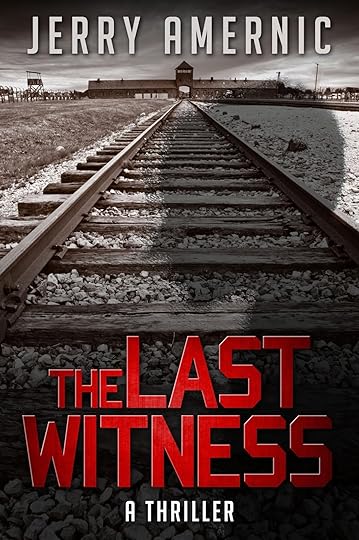 About the book:
About the book:
The year is 2039, and Jack Fisher is the last living survivor of the Holocaust. Set in a world that is abysmally ignorant and complacent about events of the last century, Jack is a 100-year-old man whose worst memories took place before he was 5. His story hearkens back to the Jewish ghetto of his birth and to Auschwitz where, as a little boy, he had to fend for himself to survive after losing all his family. Jack becomes the central figure in a missing-person investigation when his granddaughter suddenly disappears. While assisting police, he finds himself in danger and must reach into the darkest corners of his memory to come out alive.
Note from the Author:
My research included spending time with real-life, former child survivors. To illustrate the point of this novel, we produced a video and went around asking university students in Toronto where I live what they know about the Holocaust and World War II. The level of ignorance out there is incredible. Have a look.
http://youtu.be/CRC_T07dwZo
The Last Witness on Amazon: http://amzn.to/14jlgXQ
Author Bio:
 Jerry Amernic is a Toronto writer who has been a newspaper reporter and correspondent, newspaper columnist, feature contributor for magazines, and media consultant. He has taught writing and journalism at college, and is the author of several books.
Jerry Amernic is a Toronto writer who has been a newspaper reporter and correspondent, newspaper columnist, feature contributor for magazines, and media consultant. He has taught writing and journalism at college, and is the author of several books.
His first book was Victims: The Orphans of Justice, a true story about a former police officer whose daughter was murdered. The man became a leading advocate for victims of crime. Jerry later wrote a column on the criminal justice system for The Toronto Sun, and has since been a contributor to many other newspapers. In 2007 he co-authored Duty – The Life of a Cop with Julian Fantino, the highest-profile police officer Canada has ever produced and currently a member of the country’s federal Cabinet.
Jerry’s first novel Gift of the Bambino (St. Martin’s Press, 2004) was widely praised by the likes of The Wall Street Journal in the U.S., and The Globe and Mail in Canada. His latest novel is the historical thriller The Last Witness, which is set in the year 2039 and is about the last living survivor of the Holocaust. The biblical-historical thriller Qumran will be released next. It’s about an archeologist who makes a dramatic discovery in the Holy Land.
Reposted From JC's Book Haven

The thing about history is that it’s really about people, and if you don’t find people intriguing then reading books, never mind writing them, isn’t for you.
My first novel Gift of the Bambino was about baseball in the days of Babe Ruth. It was the New York Yankees and the Roaring Twenties. Sure, the story involved a little boy and his grandfather, but the book was full of history. My new novel, complete with flashbacks, is The Last Witness which is about the last living survivor of the Holocaust in the year 2039. The next one, called QUMRAN, soon to be released, is well wouldn’t you know it about an archaeologist who just happens to be an expert on the Romans.
When I was in school, history was my favorite subject and I naturally gravitated to books about a certain people in a certain place and time. In another life I would choose to be an archaeologist or paleontologist or something of that ilk. It’s in my blood, which explains why I’m a member of the local museum and watch the History Channel. Indeed, the idea of holding a fossil that’s 100 million years old, or walking around a site where a community thrived thousands of years ago always gets my juices flowing.
I felt like that exploring the old Viking settlement in Bergen, Norway. I felt like that at the Western Wall in Jerusalem. I felt like that standing in the middle of the Colosseum in Rome.
Who’s to blame? We can probably start with legendary author James A. Michener. Patron saint of the epic historical novel that runs 500, 600 or even 1,000 pages, Michener was a master at taking a place and time, then creating people and putting them in situations that keep you glued to the page, even for many hundreds of pages, and that’s no mean trick.
He penned historical novels like The Source, Centennial, Chesapeake, Mexico, Texas, Poland, and many more. I’ve read just about all of them, and some more than once. Now no one would call Michener a writer of thrillers, and he wasn’t, but if you take history and add spice in the way of suspense – think Eye of the Needle by Ken Follett – presto! You have the historical thriller.
It’s all about doing a little learning while being entertained, which is just the sort of book that keeps people like me reading in the wee hours.
 About the book:
About the book:The year is 2039, and Jack Fisher is the last living survivor of the Holocaust. Set in a world that is abysmally ignorant and complacent about events of the last century, Jack is a 100-year-old man whose worst memories took place before he was 5. His story hearkens back to the Jewish ghetto of his birth and to Auschwitz where, as a little boy, he had to fend for himself to survive after losing all his family. Jack becomes the central figure in a missing-person investigation when his granddaughter suddenly disappears. While assisting police, he finds himself in danger and must reach into the darkest corners of his memory to come out alive.
Note from the Author:
My research included spending time with real-life, former child survivors. To illustrate the point of this novel, we produced a video and went around asking university students in Toronto where I live what they know about the Holocaust and World War II. The level of ignorance out there is incredible. Have a look.
http://youtu.be/CRC_T07dwZo
The Last Witness on Amazon: http://amzn.to/14jlgXQ
Author Bio:
 Jerry Amernic is a Toronto writer who has been a newspaper reporter and correspondent, newspaper columnist, feature contributor for magazines, and media consultant. He has taught writing and journalism at college, and is the author of several books.
Jerry Amernic is a Toronto writer who has been a newspaper reporter and correspondent, newspaper columnist, feature contributor for magazines, and media consultant. He has taught writing and journalism at college, and is the author of several books.His first book was Victims: The Orphans of Justice, a true story about a former police officer whose daughter was murdered. The man became a leading advocate for victims of crime. Jerry later wrote a column on the criminal justice system for The Toronto Sun, and has since been a contributor to many other newspapers. In 2007 he co-authored Duty – The Life of a Cop with Julian Fantino, the highest-profile police officer Canada has ever produced and currently a member of the country’s federal Cabinet.
Jerry’s first novel Gift of the Bambino (St. Martin’s Press, 2004) was widely praised by the likes of The Wall Street Journal in the U.S., and The Globe and Mail in Canada. His latest novel is the historical thriller The Last Witness, which is set in the year 2039 and is about the last living survivor of the Holocaust. The biblical-historical thriller Qumran will be released next. It’s about an archeologist who makes a dramatic discovery in the Holy Land.
Reposted From JC's Book Haven
Published on February 25, 2015 00:00
February 24, 2015
Where's the Snow When You Need It?
Published on February 24, 2015 15:14
February 23, 2015
Angels in the Snow Photo Gallery
Published on February 23, 2015 15:54
Angels in the Snow
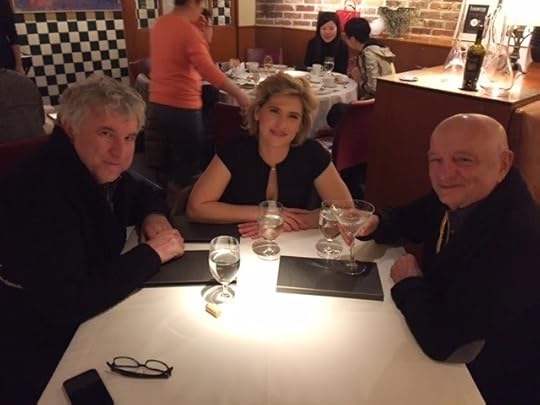 With leading lady Kristy Swanson and fellow Executive Producer Kirk Shaw at excellent Blue Water Cafe on Hamilton.
With leading lady Kristy Swanson and fellow Executive Producer Kirk Shaw at excellent Blue Water Cafe on Hamilton.— in Vancouver, British Columbia.
Published on February 23, 2015 10:50
Night Terrors In Adults: When Sleeping Turns To Terror After Dark Quotes Author Dennis Palumbo
Night Terrors Vs Nightmares Night terrors are often mistaken for nightmares, but doctors warn parents that there are telltale signs that can help distinguish the two. Nightmares often occur during the second half of the night when dreaming is most intense during REM sleep. They are “horrific dreams that we recall after awakening, and originate from dream sleep, so dream images are vivid and specific,” says Dr. Peter Fotinakes, medical director of St. Joseph Hospital's Sleep Disorders Center in Orange County, Calif. Night terrors on the other hand, are often not remembered on waking. That’s because in most cases, non-REM dreams (such as night terrors) primarily consist of brief, fragmented impressions that, compared to REM-state dreams (such as nightmares), are less emotional and less likely to involve visual images.Despite the common belief that children just “grow out of it,” sleep terrors can persist well into adulthood. Dennis Palumbo, a psychotherapist in Los Angeles, Calif., has several adult patients who report night terrors. He believes more adults are suffering from chronic fatigue and emotional fatigue, which may account for the upsurge in sleep episodes he’s seen in his private practice. Anxiety suppressed during work life, or deep-seeded issues, takes a toll on a patient’s sleep quality.
The literature on night terrors in adults is scarce since the parasomnia is commonly associated with children. The American Academy of Sleep Medicine estimates 6.5 percent of all children are affected by night terrors, followed by 2.2 percent of adults, while it remains a rare occurrence for those over the age 65. In adulthood, the sleeping disorder is suspected to be triggered by a strong genetic and family link, but there has yet to be clear empirical evidence to establish this link.
A 2014 study published in the journal Sleep found although nightmares and night terrors are a normal part of childhood development, it may also be an early indicator of mental health issues in adolescence. Children who have a frequency of nightmares before age 12 are about four times more likely to have psychotic experiences during adolescence, while those who have experienced night terrors in this group double the risk of these problems, according to the study. The researchers suggest nightmares or night terrors that occur over a prolonged period of time that persist into adolescence can be an early indicator of something more significant later in life, but that has yet to be known.
Excerpt from Medical Daily See More:
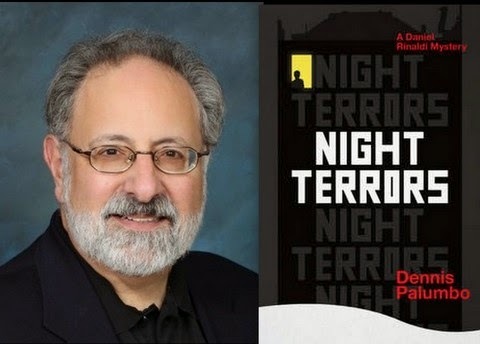 Formerly a Hollywood screenwriter (My Favorite Year; Welcome Back, Kotter, etc.), Dennis Palumbo is now a licensed psychotherapist and author. His mystery fiction has appeared in Ellery Queen’s Mystery Magazine, The Strand and elsewhere, and is collected in From Crime to Crime (Tallfellow Press). His acclaimed series of crime novels (Mirror Image, Fever Dream, Night Terrors and the latest,
Phantom Limb
) feature psychologist Daniel Rinaldi, a trauma expert who consults with the Pittsburgh Police.
Formerly a Hollywood screenwriter (My Favorite Year; Welcome Back, Kotter, etc.), Dennis Palumbo is now a licensed psychotherapist and author. His mystery fiction has appeared in Ellery Queen’s Mystery Magazine, The Strand and elsewhere, and is collected in From Crime to Crime (Tallfellow Press). His acclaimed series of crime novels (Mirror Image, Fever Dream, Night Terrors and the latest,
Phantom Limb
) feature psychologist Daniel Rinaldi, a trauma expert who consults with the Pittsburgh Police.

The literature on night terrors in adults is scarce since the parasomnia is commonly associated with children. The American Academy of Sleep Medicine estimates 6.5 percent of all children are affected by night terrors, followed by 2.2 percent of adults, while it remains a rare occurrence for those over the age 65. In adulthood, the sleeping disorder is suspected to be triggered by a strong genetic and family link, but there has yet to be clear empirical evidence to establish this link.
A 2014 study published in the journal Sleep found although nightmares and night terrors are a normal part of childhood development, it may also be an early indicator of mental health issues in adolescence. Children who have a frequency of nightmares before age 12 are about four times more likely to have psychotic experiences during adolescence, while those who have experienced night terrors in this group double the risk of these problems, according to the study. The researchers suggest nightmares or night terrors that occur over a prolonged period of time that persist into adolescence can be an early indicator of something more significant later in life, but that has yet to be known.
Excerpt from Medical Daily See More:
 Formerly a Hollywood screenwriter (My Favorite Year; Welcome Back, Kotter, etc.), Dennis Palumbo is now a licensed psychotherapist and author. His mystery fiction has appeared in Ellery Queen’s Mystery Magazine, The Strand and elsewhere, and is collected in From Crime to Crime (Tallfellow Press). His acclaimed series of crime novels (Mirror Image, Fever Dream, Night Terrors and the latest,
Phantom Limb
) feature psychologist Daniel Rinaldi, a trauma expert who consults with the Pittsburgh Police.
Formerly a Hollywood screenwriter (My Favorite Year; Welcome Back, Kotter, etc.), Dennis Palumbo is now a licensed psychotherapist and author. His mystery fiction has appeared in Ellery Queen’s Mystery Magazine, The Strand and elsewhere, and is collected in From Crime to Crime (Tallfellow Press). His acclaimed series of crime novels (Mirror Image, Fever Dream, Night Terrors and the latest,
Phantom Limb
) feature psychologist Daniel Rinaldi, a trauma expert who consults with the Pittsburgh Police.
Published on February 23, 2015 00:00
February 21, 2015
Eye on the Angels
Published on February 21, 2015 17:16
February 20, 2015
Guest Post by Jerry Amernic: “Thrillers that are big on historical fiction”
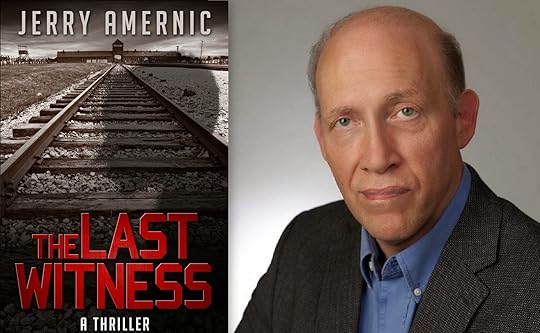
I got hooked on historical thrillers with Ken Follett’s first spy novel – Eye of the Needle. It was a suspense-packed, page turner about a Nazi agent and a lonely English woman, and how World War II depended on what they did. Talk about raising the stakes for the reader! A phenomenal best-seller, it was made into a motion picture.
Follett, one of the world’s most successful thriller writers, later turned to long epics that were full of history and not so much on suspense. They were books like The Pillars of the Earth, which is also a very good read.
As a history nut, I enjoy well-written books that focus on a particular time and place, or a particular place over a long length of time. A good example of the latter is The Thorn Birds by Colleen McCullough, who just passed away, or any historical epic by James A. Michener. My favorite is The Source, which covers the fictional community of Makor in northern Israel over thousands of years. In a nutshell, it’s a history of the Jewish people.
Those novels aren’t thrillers, but it all depends on your preference. A reader who likes history opts for books about a time and place, while one who’s into thrillers goes for books with great pacing and suspense. Put them both together and you have the historical thriller.
But writing about history requires care. Unless it’s fantasy, the book should be more or less historically accurate. I say ‘more or less’ because authors approach this differently. I’m a stickler for accuracy since I don’t change the year something happened or where it happened just to make things convenient for a character. I choose to take a time and place, then have my characters and situations conform to historical fact. Other writers may be more loose with this.
In writing about the last living survivor of the Holocaust for The Last Witness, I did research that was crucial to the story. Like the Jewish Ghetto in the Polish city of Lodz. And the death camp of Auschwitz. These were important to my flashbacks because the central character is a little boy in those places, but he manages to survive.
Fast forward to the year 2039 when that little boy is 100 years old and the last living survivor of the Holocaust. However, he’s in a world woefully ignorant of the past century. This is where I write about how things may be, but even so, I like to portray a future that is credible. That explains why I recently made a video asking university students what they know about the Holocaust and World War II. It was readily apparent to me that they don’t know much. See for yourself – http://youtu.be/CRC_T07dwZo.
So maybe my future world of ignorance and complacency isn’t such a stretch after all.
– Jerry Amernic
About Jerry’s latest book The Last Witness:
The year is 2039, and Jack Fisher is the last living survivor of the Holocaust. Set in a world that is abysmally ignorant and complacent about events of the last century, Jack is a 100-year-old man whose worst memories took place before he was 5. His story hearkens back to the Jewish ghetto of his birth and to Auschwitz where, as a little boy, he had to fend for himself to survive after losing all his family. Jack becomes the central figure in a missing-person investigation when his granddaughter suddenly disappears. While assisting police, he finds himself in danger and must reach into the darkest corners of his memory to come out alive.
The Last Witness on Amazon: http://amzn.to/14jlgXQ
About Jerry Amernic:
Jerry Amernic is a Toronto-based writer who has been a newspaper reporter and correspondent, newspaper columnist, feature contributor for magazines, and media consultant. He has taught writing and journalism at college, and is the author of several books.
His first book was Victims: The Orphans of Justice, a true story about a former police officer whose daughter was murdered. The man became a leading advocate for victims of crime. Jerry later wrote a column on the criminal justice system for The Toronto Sun, and has since been a contributor to many other newspapers. In 2007 he co-authored Duty – The Life of a Cop with Julian Fantino, the highest-profile police officer Canada has ever produced and currently a member of the country’s federal Cabinet.
Jerry’s first novel Gift of the Bambino (St. Martin’s Press, 2004) was widely praised by the likes of The Wall Street Journal in the U.S., and The Globe and Mail in Canada. His latest novel is the historical thriller The Last Witness, which is set in the year 2039 and is about the last living survivor of the Holocaust. The biblical-historical thriller Qumran will be released next. It’s about an archeologist who makes a dramatic discovery in the Holy Land.
Jerry’s Website: http://thelastwitness.ca/
Jerry’s Facebook: http://on.fb.me/1DuRSdn
Jerry’s Twitter: https://twitter.com/jerryamernic
Jerry’s Goodreads: https://www.goodreads.com/author/show/1312217.Jerry_Amernic
Reposted from The Indie Writes SoCal
Published on February 20, 2015 00:00


